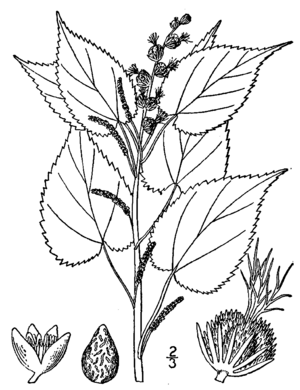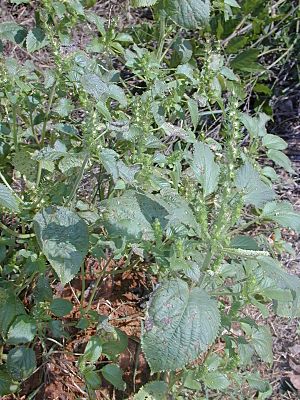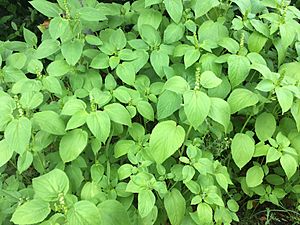Acalypha ostryifolia facts for kids
Quick facts for kids Acalypha ostryifolia |
|
|---|---|
 |
|
| Drawing of Acalypha ostryifolia | |
 |
|
| Photo of Acalypha ostryifolia | |
| Scientific classification | |
| Genus: |
Acalypha
|
| Species: |
ostryifolia
|
| Synonyms | |
|
|
Acalypha ostryifolia, also called hophornbeam copperleaf, hornbeam copperleaf, or pineland threeseed mercury, is a type of plant in the Euphorbiaceae family. It's an annual herb, which means it lives for only one growing season. This plant is part of the Acalypha genus, often called the copperleaf genus.
It originally comes from North and Central America. Many people consider it a weed, which is a plant growing where it's not wanted.
Contents
What Does This Plant Look Like?
Acalypha ostryifolia is an annual herb that can grow up to 75 centimeters (about 30 inches) tall. Its stems stand straight up and have branches. They are usually purplish-green with thin lines running vertically. The stems also have short, curved hairs and tiny glands on stalks.
Leaves and Flowers
The leaves grow one after another along the stem. They have stalks (called petioles) and are simple, meaning each leaf is one single blade. Their shape is like an egg (called ovate). The edges of the leaves can be jagged (serrate) or toothed (dentate). The base of the leaf is heart-shaped (cordate), and they have a few soft hairs (pubescence). These leaves can grow up to 10 centimeters (about 4 inches) long.
This plant has separate male and female flowers. The male flowers grow on short spikes that come out from the leaf joints. The female flowers grow on longer, broken-up spikes at the very top of the plant.
- Male flowers have four green, egg-shaped sepals (leaf-like parts that protect the flower bud). These sepals are often tinged with red. They do not have any petals.
- Female flowers also do not have petals. They have three styles that split into many white hairs. These hairs make the whole flower cluster (called an inflorescence) look a bit furry.
Seeds and Fruits
After flowering, the plant produces a fruit that looks like a small, three-lobed capsule. It's usually round to egg-shaped and about 5 millimeters (0.2 inches) wide. Inside, there are typically three egg-shaped, wrinkled seeds. These seeds are about 2 millimeters long and are brown with small bumpy ridges. The plant usually flowers from June to November.
Where Does It Grow?
Acalypha ostryifolia is found in many places. It grows naturally in:
- Caribbean: Cuba, Dominican Republic, Haiti, Jamaica, Puerto Rico, and the West Indies.
- Central America: Mexico, Guatemala, Belize, Costa Rica, El Salvador, Honduras, Nicaragua.
- South America: Ecuador.
- United States: Many states, including Alabama, Arkansas, Arizona, Florida, Georgia, Iowa, Illinois, Indiana, Kansas, Kentucky, Louisiana, Missouri, Mississippi, North Carolina, Nebraska, New Jersey, New Mexico, Ohio, Oklahoma, Pennsylvania, South Carolina, Tennessee, Texas, Virginia, and West Virginia. It also grows in the US territories of Puerto Rico and the US Virgin Islands.
This plant has also been introduced to Southern Italy.
Preferred Places to Grow
You can find Acalypha ostryifolia in various environments. It likes to grow along riverbanks, in open fields, on bluffs, and along roadsides. It also thrives in canyons and on slopes. Sometimes, it can appear (be adventive) in farm fields, where it might become a problem for crops.
How Does It Interact with Nature?
The hophornbeam copperleaf is a common weed that grows in summer, especially in farm fields and other disturbed areas. Its seeds sprout easily (have a high germination rate). The young plants are tough and can handle cold weather. They also grow very quickly, sometimes as fast as soybean plants in the Midwest.
Farmers often use chemicals called herbicides to control weeds. This plant is resistant to most herbicides used on soybean crops. However, some herbicides like lactofen, acifluorfen, and fomesafen can control it well, killing over 80% of the plants. Lactofen is especially effective, killing about 95% of the hophornbeam copperleaf.
A Friend to Lady Beetles
Interestingly, the spotted lady beetle (Coleomegilla maculata) often lays its eggs on this plant. This happens when the weed grows near sweet corn crops in places like Kentucky. Scientists have studied this and found that the lady beetles actually preferred to lay their eggs on the weed rather than on the corn. This was true even when the corn had aphids (tiny insects that lady beetle larvae eat) and the weed did not.
The young lady beetle larvae would hatch on the weed, then fall to the ground and crawl over to the sweet corn plants. Having the hophornbeam copperleaf growing close to the corn was actually helpful! It led to more lady beetle larvae on the corn plants and fewer aphids, which are pests for corn. So, sometimes a "weed" can actually help other beneficial insects!
Gallery





